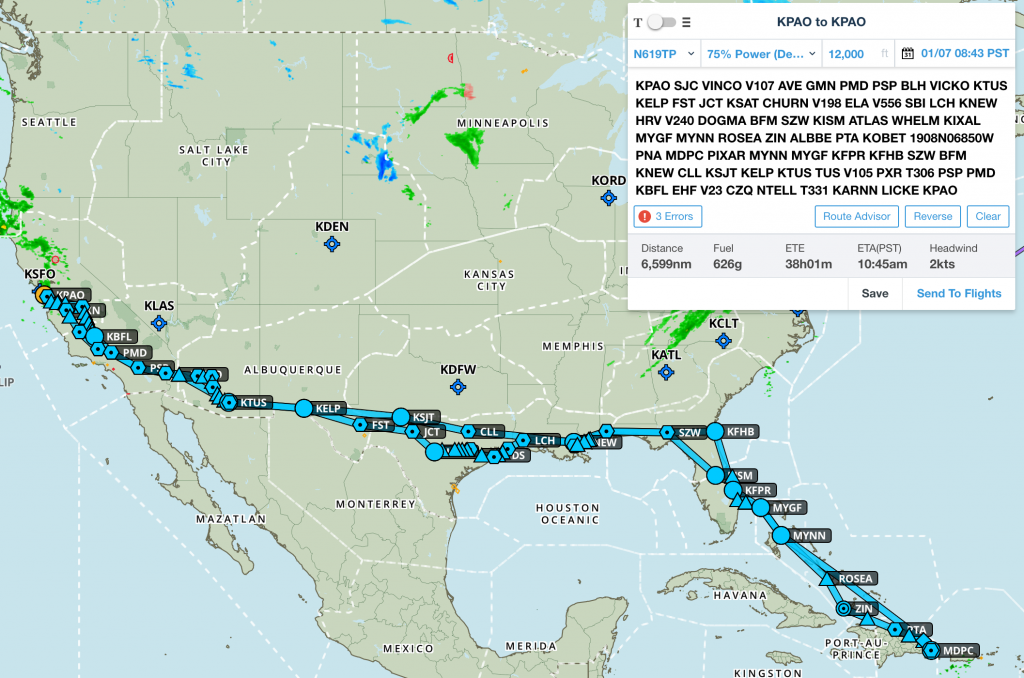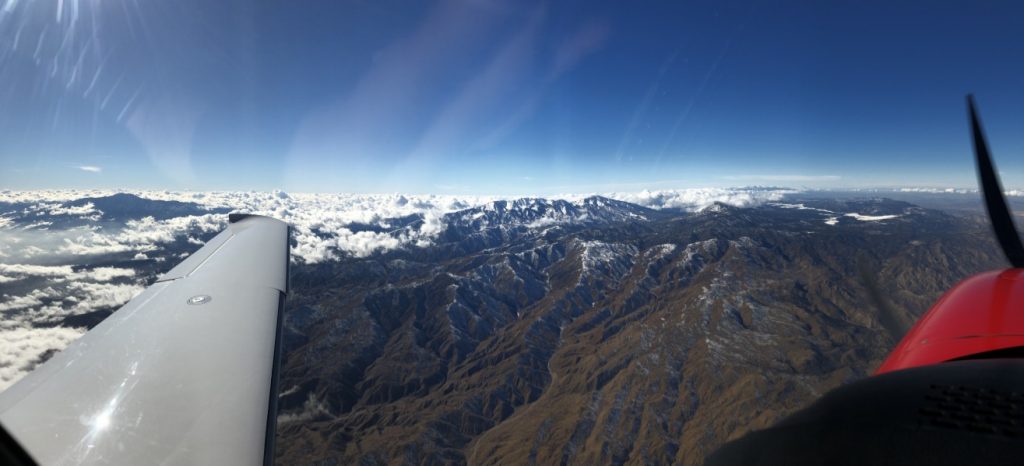N619TP is back from the Caribbean and safely parked on the ramp at Palo Alto Airport. It has been an amazing experience and I am still digesting the learning from it. For the detailed write up check out Part 1, Part 2, Part 3 and Part 4.

The approximate routing for the return trip is shown above. Total length of the trip is about 6,600 nautical miles (7,500 miles or 12,200 km). The flight had 14 segments, 6 to Punta Cana and 8 back. Heading west will take you more time because of headwinds (up to 40 knots) and customs when entering the US. Longest segment was 5.2 hours from Nassau to Punta Cana. Picking a route far south was the right choice as it kept us out of clouds with icing.
Total Hobs time was about 45.8 hours. I was PIC for 100% of the trip, 100% of the time was IFR and crossing the US on the way back from Florida to Palo Alto was me flying solo. The SR22T was usually at 75% power although the longest leg was at 65% power to conserve fuel. I haven’t tallied up the exact amount of fuel but Foreflight’s estimate of 625 gallons sounds about right. At $6.00/gallon average ($4.99 in New Orleans, > $7 in the Caribbean) total cost for fuel is about $3,750. In total, cost for the flight was probably around $4,000.
Small Plane vs. Flying Commercial
A commercial flight to Punta Cana from SFO costs around $600-$1500 and takes 10-15 hours one way with typically one stop. A Boeing 737 uses approximately 0.5-1 gallon/passenger/100km or 60-120 gallons/person. The SR22T is a 5 seater, although flying with 2 adults and 3 kids would require additional fuel stops due to weight limits. But even then flying commercial is faster and almost always cheaper. Fuel consumption is surprisingly close, but in the end this is a trip that only makes sense if you like flying.
Where else could I have gone?
Direct distance to Punta Cana is about 3,000 nm. In the same time I could have reached the northernmost point of Alaska (Point Barrow, 2,200nm), Kangerlussuaq in Greenland (2,900nm), or South America (Colombia, 3,000 nm). I see more long-distance trips in my future.
Logistics
Logistics add a fair amount of complexity to the trip. While in the US, the FBO’s at major airports tend to be well organized and very helpful. Foreflight works great for filing plans, receiving routes and (where available) getting them via PDC. Complexity starts once you cross the border.
Departing and entering requires eAPIS filings. Setting up an account takes up to a week, but the actual filing is quick and painless. Flying across the ADZ (Air Defense Zone) requires a flight plan which Foreflight will handle. Re-entering the US also requires notifying customs via phone. This is also quick and they give you the initials of the customs officer as a confirmation that you are scheduled. The AOPA guide for flying to the Bahamas has all the necessary information. For us, customs and immigration took under 15 minutes.
Any guide about flying in the Caribbean will tell you that anything you do requires a lot of paperwork. Well, I guess that’s true but you can mitigate this with a good FBO or handler. We used Odyssey in Nassau and Trading Aviation in Punta Cana. Both were fantastic and they made the paperwork disappear. You land, get out of the plane, various forms change hands between your handler and various officials and within 10 minutes you are in a taxi to your hotel. We asked Trading Aviation in Punta Cana how to file a flight plan (electronic filing doesn’t work yet in the DR) and they had already filed one for us. During the entire time in the Caribbean, I did not fill out a single form. Cost of handling services varies considerably. Check prices before you go and bring cash as some locations don’t accept credit cards.
ATC was very professional along the entire way. Flying out of radar coverage with position reporting took some getting used to but controllers are friendly and explain what they want from you if you ask them.

TL;DR: If you like flying, you should do this.
This was one of the most amazing trips I have done in my life. Crossing the US and gradually seeing the landscape change from California to the Arizona Desert, the Mexican Border in El Paso, oil fields in Texas, Bayous in Louisiana, flying over Disney World in Florida and seeing the Bahamas from the air was were incredible sights to behold. I learned a lot as a pilot about logistics but also trip planning and risk management. The last day of flying took me into a cold front with heavy rains and icing levels as low as 6000 ft. Understanding how to navigate through it and landing in Palo Alto in heavy rains with low ceilings and a circle-to-land approach stretched the limits of my aviation skills.
If you like piloting planes, I can highly recommend this trip. It’s an amazing experience and you will learn a lot as a pilot. And if nothing else, it will show you the beauty and diversity of the USA and the Caribbean.
Cost aside, I’ll take PIC over Passenger EVERY TIME!!! Great trip. Congratulations.